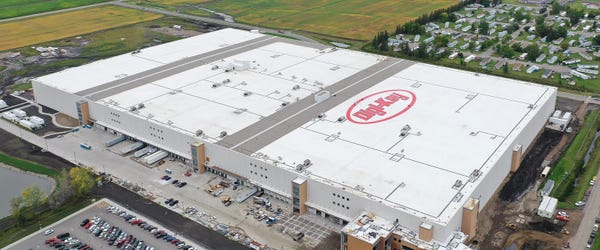Industry Voices: The State of Automation? A Rough Year has Opened the Floodgates
With the pandemic, tech development, and the need to replace workers, automation is growing in every industry.
August 3, 2021

Automation has changed considerably in recent years, from sensors and networking that enhance existing equipment to robotics and motion control products that deliver a predictable return on investment. The pandemic gave automation a significant boost. Companies sought automation technology to overcome social distancing and worker shortages.
Companies like Digi-Key offered help to companies as they built their automation systems. Sometimes it was a matter of transforming existing equipment into automation systems. Other times it was a matter of deploying entirely new equipment.
We caught up with Hermann Reiter, managing director of Global Strategic Business Development & Supplier Management at Digi-Key, to learn the developing trends in automation.

Design News: What is Digi-Key’s role in developing automation systems?
Hermann Reiter: Digi-Key continues to offer a one-stop-shop for engineers and prototyping needs for products and services around automation, robotics, safety, and Industrial IoT (IIoT). With the industry moving to more individual products in automation and production – alongside robotics – I think adaptability and change readiness will be most important.
The electronic components, board-level products, and finished IIoT products all work to help to connect existing and new machinery. The biggest benefit is that electronics will utilize the current equipment and build a network and system – so not everything has to be bought new. Fast and immediate results can be achieved by adopting best practices when automating current standard routines of processes, behaviors, and check and test routines. The result is routines that are digitized and automated, and much more efficient.
DN: What industries are growing in automation? Pharma? Consumer packaged goods? Packaging? Aerospace? Automotive?
Hermann Reiter: I strongly believe that automation has only just begun. Once the full benefit of security, connectivity, automation cobotics, and PaaS (Product as a Service) is realized by companies and organizations, all industries will experience an energized surge of automation activity. Besides the usual suspects, many industries like healthcare – especially surgery – functional safety, photonics, agriculture, and others will embrace these automation tools moving forward.
It will also be exciting to see how law enforcement continues to implement greater automation for security. Interestingly, while automation began in the automotive sector, we are seeing that is now one of the slowest growing industries for deployment.

DN: What new automation equipment are you supporting? Robotics? IIoT systems? Predictive maintenance programs?
Hermann Reiter: Digi-Key supports all types of automation equipment and engineers working in this space. Recently, we’ve been seeing an influx of more finished products and support equipment across industries. We’ve also noticed an uptick in off-the-board products being utilized on, around, nearby, and next to the board and system.
Digi-Key has also always maintained a strong sensor supply. When it comes to predictive maintenance in automation, our sensor selection and support for those in need of fast prototypes are unmatched, both in wired and wireless applications.
DN: How has the pandemic affected automation?
Hermann Reiter: The pandemic has been a catalyst for greater automation in many manufacturing and production plants. Some experts argue that the pandemic sped up the adoption of automation by 3-5 years. Restrictions and the spread of the virus directly impacted productivity during the last year, and many companies began to look at automation as a solution that could meet the need for an uninfectable workforce. It’s also worth noting that in certain industries, like medical and food production, automation enabled companies to ensure their production areas were cleaner than ever before.
Finally, COVID brought data privacy activities into clearer focus. Not only were more products reviewed and made digital, but automation also raised the question of data security. This continues to be one of the biggest challenges in automation: cyber-attacks and other malicious activity attempt to steal and copy important data. Unfortunately, these attacks only grew in sophistication and frequency as the COVID pandemic pushed more interactions online.
Now, there will be billions of wireless modules used on manufacturing floors and if that data is unprotected, it can cause disruptions in service, data leaks, negative brand reputation, heavy regulatory fines, or serious industrial accidents. As the Industrial Internet of Things (IIoT) becomes more prevalent in the manufacturing space, especially in the wake of the pandemic, protecting sensitive data will be more important than ever.
DN: Who is typically involved in automation projects? Inhouse teams of engineers and systems folks? Integrators?
Hermann Reiter: Automation is often a combination of current assets or machinery, along with brand new automation equipment. The challenge is how to best “weld” it together. Many times external experts are needed, but most of the time companies find great potential within their workforce. Typically, combining that with external resources is a best practice.
DN: Do you see automation equipment is easier to run because low-code or configuration is replacing original programming?
Automation equipment is already much more user-friendly than ever before. Without losing the complexity inside the device, it comes with a much more “plug-and-play” systematic.
Part of the benefit is the rejuvenation of the staff in and alongside the machinery. We’ll see many more change-ready and tech-savvy staff in the next generation.
DN: Where do you see the future of automation? And what industries are leading in automation development? Auto? Aerospace? Pharma or medical?
Hermann Reiter: A huge push for automation right now is the labor shortage that remains in the manufacturing workforce. Four and a half million manufacturing jobs are needed, yet 2.4 million are expected to go unfilled (National Association of Manufacturers, 2018). In addition to a lack of workers, there’s an even greater need for qualified talent.
While all of these factors are accelerating the future of automation, I see Industry 5.0 as the gold standard moving forward. This concept marries the idea of accelerating automation, along with putting the human touch back into development and production. By adopting an Industry 5.0 approach, we’ll have a higher degree of control and the ability to individualize every phase of production.
Robots will be able to handle tedious tasks, while our human workforce will be made up of individuals with significant technical and soft skills who can do the interesting, creative thinking involved in manufacturing. This is a huge revolution in our industry, and I believe that future factories will be shaped by Industry 5.0, as well as the smart technology that is critical to implementing it.
I also feel we will continue to see an acceleration of computer vision on factory floors. Computer vision seeks to automate tasks traditionally completed by human eyes. Incorporating this capability into our industrial sector will help guide operators through processes in a more reliable way and by doing so, improve health and safety on the shop floor. Overall, we can expect generative design to speed up innovations since multiple outputs will boost productivity.
Leonardo da Vinci once said: “Learn how to see. Realize that everything connects to everything else.” I don’t think this has ever been truer than in our current period of innovation in the automation space. Now, with 5G networks emerging to support our increasingly connected society, we’re realizing that everything works better when it is connected, and that data is the new oil that will propel our world forward. As always, Digi-Key is here for engineers every step of the way.
Rob Spiegel has covered manufacturing for 19 years, 17 of them for Design News. Other topics he has covered include automation, supply chain technology, alternative energy, and cybersecurity. For 10 years, he was the owner and publisher of the food magazine Chile Pepper.
About the Author(s)
You May Also Like





